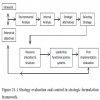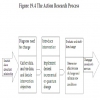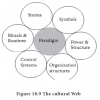Strategic Management - Strategy Implementation
Concept and Sources of Power - Power, Politics And Leadership
Posted On :
The term power may be applied to individuals, groups, teams, departments, organizations, and countries.
Concept and Sources of
Power
The term power may be applied to individuals, groups, teams, departments, organizations, and countries. Power influences may affect resource allocations, space assignments, goals, hiring decisions, and many other outcomes and behaviors in an organization. It is defined as follows.
Power is the capacity to influence the behavior of others.
There are different sources of power. They are broadly divided into
(i) interpersonal sources and (ii) structural sources. They are further classified as shown in Figure 20-1.
Reward power is individual’s ability to influence others’ behaviors by rewarding their desirable behaviors. Compliance with requests and directives depends on rewards and the value of rewards to the recipients. Therefore, a superior can get desirable behaviors only when the rewards he has offered are valuable to the subordinates.
Coercive power is an individual’s ability to influence others’ behaviors by punishing their undesirable behaviors. For example, subordinates may comply because they expect to be punished for failure to respond favorably to managerial directives. Punishment may take the form of reprimands, undesirable work assignments, closer supervision, tighter enforcement of work rules, suspension without pay, and the like. The organization’s ultimate punishment is to fire the employee.
Legitimate Power most often refers to a manager’s ability to influence subordinates’ behaviors because of the manager’s formal position in the organization. Subordinates may respond to such influence because they acknowledge the manger’s legitimate right to prescribe certain behaviors.
Expert power is an individual’s ability to influence others’ behaviors because of recognized competencies, talents, or specialized
Referent Power is an individual’s ability to influence others’ behaviors as a result of being respected, admired, or liked. For example, subordinates’ identification with a manager often forms the basis for referent power. This identification may include the desire of subordinates to emulate the manager. A young manager may copy the leadership style of an older, admired, and more experienced manager. The older manager thus has some ability-some referent power-to influence the behavior of the younger manager.

Structural sources of power are related to the division of labor and position in different teams and departments work assignments, locations and roles. The positions in hierarchy naturally result in a variety of situations in which there is unequal access to information, resources, and decision making.. Any of the situational factors could be a source of power in an organization, which include knowledge, resources, decision-making and networks.
Knowledge power – This power is from knowledge-information and know-how that exists in an organization. Those in a position to control information about current operations, develop information
Personal computers and computerized workstations are having a dramatic impact on the access to and use of information-and thus on power relationships-in many organizations.
Resources power – Organizations need a variety of resources, including human resources, money, equipment, materials, supplies, and customers, to survive. The importance of specific resources to a firm’s success and the difficulty of obtaining them vary. The old saying that “he who has the gold makes the rules” sums up the idea that resources are power. Those having resources exercise power.
Today companies are adopting retention strategies to retain competent employees. Skilled people have power advantage over the less skilled people.
Decision-making power – Decisions in organizations often are made sequentially, with individuals, groups, or teams participating. The decision-making process creates additional power differences. Those who are in the critical positions of decision-making process might influence power. They influence the goals being developed, premises being used in evaluating an issue, alternatives being considered, outcomes being projected, and so on.
Consider, purchase process of a firm. If the plant superintendent is the one who has to approve the quotation submitted by the suppliers, the purchase manager has to wait for the decision of Plant superintendent.
Network power – Managers and departments that have connecting links with other individuals and departments in the organization will be more powerful than those who don’t. The concept of networks as power implies that various affiliations, channels of information, and coalitions, both inside and outside the organization, represent sources of power. These networks can be information links, supply links and support links.
Lower level employee power – In organizations lower level employees also may wield considerable power. One of the sources can be expert power, which may allow subordinates to influence their managers.
For example, an office assistant who can use windows 98 spread sheet can influence his manager if he is not familiar with the same.
The term power may be applied to individuals, groups, teams, departments, organizations, and countries. Power influences may affect resource allocations, space assignments, goals, hiring decisions, and many other outcomes and behaviors in an organization. It is defined as follows.
Power is the capacity to influence the behavior of others.
There are different sources of power. They are broadly divided into
(i) interpersonal sources and (ii) structural sources. They are further classified as shown in Figure 20-1.
(a) Interpersonal sources of power
Reward power is individual’s ability to influence others’ behaviors by rewarding their desirable behaviors. Compliance with requests and directives depends on rewards and the value of rewards to the recipients. Therefore, a superior can get desirable behaviors only when the rewards he has offered are valuable to the subordinates.
Coercive power is an individual’s ability to influence others’ behaviors by punishing their undesirable behaviors. For example, subordinates may comply because they expect to be punished for failure to respond favorably to managerial directives. Punishment may take the form of reprimands, undesirable work assignments, closer supervision, tighter enforcement of work rules, suspension without pay, and the like. The organization’s ultimate punishment is to fire the employee.
Legitimate Power most often refers to a manager’s ability to influence subordinates’ behaviors because of the manager’s formal position in the organization. Subordinates may respond to such influence because they acknowledge the manger’s legitimate right to prescribe certain behaviors.
Expert power is an individual’s ability to influence others’ behaviors because of recognized competencies, talents, or specialized
Referent Power is an individual’s ability to influence others’ behaviors as a result of being respected, admired, or liked. For example, subordinates’ identification with a manager often forms the basis for referent power. This identification may include the desire of subordinates to emulate the manager. A young manager may copy the leadership style of an older, admired, and more experienced manager. The older manager thus has some ability-some referent power-to influence the behavior of the younger manager.

(b) Structural sources of power
Structural sources of power are related to the division of labor and position in different teams and departments work assignments, locations and roles. The positions in hierarchy naturally result in a variety of situations in which there is unequal access to information, resources, and decision making.. Any of the situational factors could be a source of power in an organization, which include knowledge, resources, decision-making and networks.
Knowledge power – This power is from knowledge-information and know-how that exists in an organization. Those in a position to control information about current operations, develop information
Personal computers and computerized workstations are having a dramatic impact on the access to and use of information-and thus on power relationships-in many organizations.
Resources power – Organizations need a variety of resources, including human resources, money, equipment, materials, supplies, and customers, to survive. The importance of specific resources to a firm’s success and the difficulty of obtaining them vary. The old saying that “he who has the gold makes the rules” sums up the idea that resources are power. Those having resources exercise power.
Today companies are adopting retention strategies to retain competent employees. Skilled people have power advantage over the less skilled people.
Decision-making power – Decisions in organizations often are made sequentially, with individuals, groups, or teams participating. The decision-making process creates additional power differences. Those who are in the critical positions of decision-making process might influence power. They influence the goals being developed, premises being used in evaluating an issue, alternatives being considered, outcomes being projected, and so on.
Consider, purchase process of a firm. If the plant superintendent is the one who has to approve the quotation submitted by the suppliers, the purchase manager has to wait for the decision of Plant superintendent.
Network power – Managers and departments that have connecting links with other individuals and departments in the organization will be more powerful than those who don’t. The concept of networks as power implies that various affiliations, channels of information, and coalitions, both inside and outside the organization, represent sources of power. These networks can be information links, supply links and support links.
Lower level employee power – In organizations lower level employees also may wield considerable power. One of the sources can be expert power, which may allow subordinates to influence their managers.
For example, an office assistant who can use windows 98 spread sheet can influence his manager if he is not familiar with the same.
Tags : Strategic Management - Strategy Implementation
Last 30 days 686 views
















